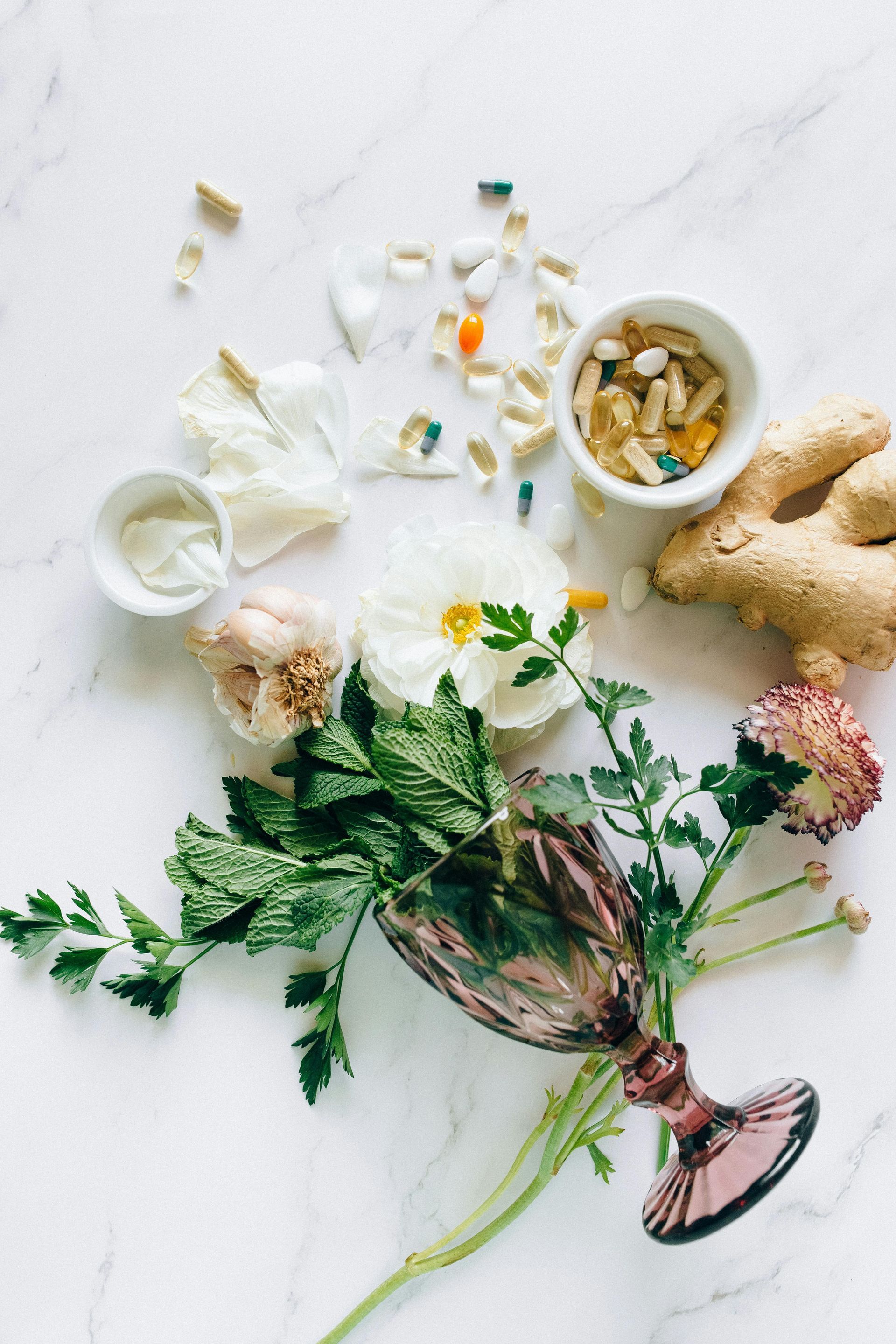Chinese Herbal Medicine
Chinese herbal medicine is an integral part of traditional Chinese medicine (TCM), developing over thousands of years, and continues to be a cornerstone of many acupuncture practices today. Chinese medicine is a combination of all the modalities that developed in the various geographic areas of China over the centuries: acupuncture, moxibustion, herbal medicine, and other related techniques. Over the years the modalities coalesced into what is now referred to as traditional Chinese medicine.
Chinese herbal medicine works on the same principles as acupuncture. The actions of the herbs as used in Chinese medicine often bear little resemblence to the actions of the same herbs used in conventional western medicine. Chinese medicine works with the body’s energy, as well as the physical body. Regulating qi, supplementing qi and blood, draining heat and damp, and warming the interior are commonplace goals when putting together a formulation that meets the patient’s needs based on their signs and symptoms. Because we work within the confines of Chinese medicine, it is important to diagnose and treat within those parameters. I use herbal formulas for many of my patients, both patients with vision disorders, and those who come for general acupuncture.
Safety of Chinese Herbal Medicine
Chinese medicine herbal formulas are very safe when formulated by a trained practitioner of Chinese medicine. First, herbs are almost always taken in a formula, consisting of anywhere from two to 30 herbs. Formulas are standard remedies that have been used for hundreds, in some cases thousands of years, and are used for specific patterns of imbalance, as determined during the evaluation and questioning. Patients take one dose of the formula three times a day. Each dose consists of small amounts of many herbs that work together to achieve the goal of the formula for the individual patient, and to keep balance within the formula. Further, rarely do we use raw herbs -- allowing for easier digestion. All herbs are prepared, usually by cooking. Until recently, patients were given a bag of herbs, roots, berries, minerals and other substances - any substance that is ingested is considered herbal - that they took home and cooked in a large pot, taking one cup three times a day. Now, many of the herbs are cooked, then dehydrated and sold in the form of tablets, capsules or powders to be mixed in warm water. Tinctures are also available.
When I am treating patients with degenerative eye diseases such as macular degeneration, retinitis pigmentosa, glaucoma and other vision conditions, I often recommend formulas I have developed to help enhance the acupuncture treatment they are receiving for their degenerative eye disorder. The acupuncture treatment I use is called microacupuncture
and has been very effective to help heal damage caused by eye disease as well as stablizing the eye condition. The herbal formulas, taken daily, have the potential to help minimize the loss experienced between treatment courses. Most patients come for week long treatment and wait 4 to 12 months for the next course depending on their eye disease, the progression, and the severity of their condition.
Herbal formulas for vision health
There are two Chinese herbal formulas I recommend for most of my patients with vision problems stemming from various eye diseases. They are described below.
Herbal formulas for vision health
Ocular Renewal
The first formula, Ocular Renewal, is used for all vision conditions and is based on the traditional formula recommended for most eye conditions: Qi Ju Di Huang Wan. Added to this formula are frankincense and myrrh used to help encourage the blood deeper into the tissue using of the eyes. Myrrh is a strong anti-inflammatory and helps protect blood vessels.
The first formula, Ocular Renewal, is used for all vision conditions and is based on the traditional formula recommended for most eye conditions: Qi Ju Di Huang Wan. Added to this formula are frankincense and myrrh used to help encourage the blood deeper into the tissue using of the eyes. Myrrh is a strong anti-inflammatory and helps protect blood vessels.
Angelica helps guide the herbs to the orifices of the head, including the eyes. Curcumin, a natural compound found in turmeric, has shown promise in treating various eye disorders due to its antioxidant, anti-inflammatory, and anti-angiogenic properties. Substances with anti-angiogenic properties are important to prohibit the formation of new blood vessels, an action critical to keep macular degeneration from progressing to the ”wet” type of AMD. Many of the herbs in this formula have this important quality.
Atractylodes Root is thought to help conditions such as night blindness and optic atrophy. Scuttellaria contains antioxidant, anti-inflammatory and neuroprotective properties, and these properties have the potential to manage and prevent glaucoma and AMD. Dang Gui, or Angelica, also supports eye health due to its anti-inflammatory and antioxidant properties.
Because it regulates the Liver qi and nourishes Liver blood, this will benefit eye disorders in terms of Chinese medicine properties. The Liver is the organ the opens into the eyes (according to TCM principles); nourishing this organ can therefore nourish the eyes.

HBO1
HBO1* is a Chinese medicine herbal formula developed and named in China for those suffering from Wet macular degeneration. It reduces choroidal neovascularization (new blood vessel growth) by regulating the expression of vascular endothelial growth factor* Typically patients receive injections for control of the growth of abnormal blood vessels that grow through the retina, and to stop the leaking caused by these new blood vessels. When fluid leaks into the retina or vitrous, the jelly-like fluid the fills the inner chamber of the eye and keeps the eye from collapsing, vision loss can occur. The injections patients receive help control the growth of abnormal vessels and the resultant leaking. The formula HBO-1 works in the same way as medication such as Avastin and Lucentis, which inhibits the growth of new blood vessels, helping to reduce leakage and improve vision. This Chinese medicine formula has helped many patients keep the eyes from developing the blood vessels that, if leaking, can cause significant vision loss. It is not recommended for any patient to discontinue the treatment they receive from their eye doctor unless it is recommended by their physician. However, HBO1 can be used in conjunction with their conventional therapy.
There are eight herbs in the HBO1 formula. Cattail pollen and panax notoginseng, stop bleeding, invigorates blood flow and disperses blood stasis, allowing for normal blood flow. It is the bleeding stopping category where bleeding is thought to occur from blocked blood flow. Angelica nourishes the eyes by nourishing and invigorating the blood. Fritillary bulb reduces inflammation. Orange peel is a gentle herb that regulate the Qi and dries dampness and helps in digestion of the other herbs in the formula. Astragalus nourishes the qi, supports the immune system and is important for wound healing. Curcumin is an antioxidant, anti-inflammatory and anti-angiogenesis properties. Like curcumin, astragalus and rhubarb root have anti-angiogenesis properties. Angiogenisis is the formation of new, abnormal blood vessels. Because these newly formed blood vessels are weak, they can leak fluid, causing vision loss, sometimes severe and rapid loss. Wet macular degeneration is diagnosed when examination of the eye shows the growth of new blood vessels growing through the retina. Neovascularization ais the term often used when referring to blood vessel growth within the retina. It is vital to treat this condition. Angiogenesis is a form of neovascularization. Angiogenesis is the term used when applied to blood vessels that feed tumors in any part of the body. Anti-angiogenesis substances stop the formation of the new blood vessels.
*Jin M, Zhang Y, Pan L, Dou R, Nussenblatt RB, Wei L. The Chinese medicine formula HB01 reduces choroidal neovascularization by regulating the expression of vascular endothelial growth factor. J Transl Med. 2012 Jun 7;10:118. doi: 10.1186/1479-5876-10-118. PMID: 22676316; PMCID: PMC3479009.
Wet and Dry AMD
Wet macular degeneration is not a different condition from the “dry” type. There is only one disease: macular degeneration. Wet AMD is a progression of the disease AMD. About 10 to 15 percent of cases of macular degeneration progress to become wet AMD.
Contact Us


